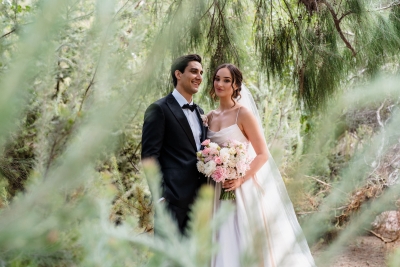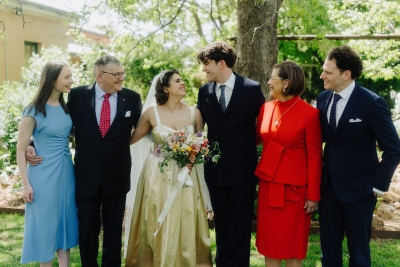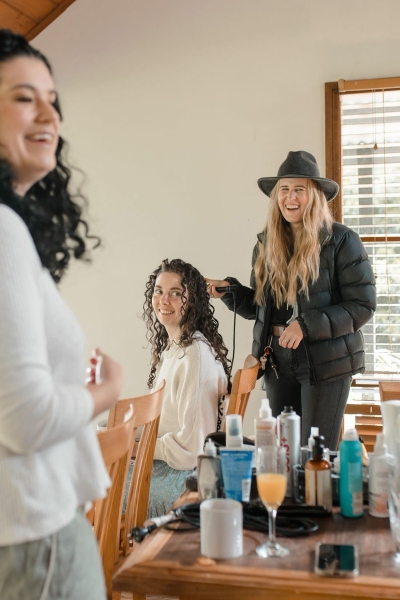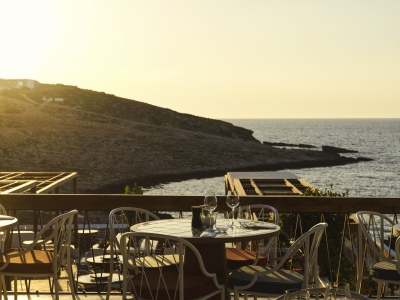At Polka Dot Wedding, we believe every love story deserves to be celebrated in a way that feels inclusive, thoughtful, and welcoming to all. That’s why we’re so honoured to share this deeply personal and incredibly insightful piece from celebrant, storyteller, and access/inclusion specialist, Diana Fisk. Diana shares the journey that led her to become a passionate advocate for accessibility, and offers practical, heartfelt advice to help couples create ceremonies that embrace and support every guest. Here are her tips on creating an accessible and inclusive wedding ceremony.
Photography by Cloud Catcher Studio via Bronwyn & Jodie’s Vibrant Wedding at Fins At Plantation House
It was over ten years ago now; the well-intentioned nurse looked into the eyes of my brand new and already beloved baby and said the words to me ‘See that? That’s not normal’.
I lost the breath in my chest and for almost another ten months I continued to feel like I could hardly breathe. The words stung—not only because they were said about my baby but because they framed difference as something wrong. I was so desperate for answers and fearful of what could be a hard life for my little boy.
Finally receiving answers at least there was something I could research and some power in having the information we so desperately waited for. My little boy, Alfie, had a congenital vision condition called Nystagmus along with Ocular Albinism.
He was also already quite the charmer, a blissful sleeper and was born with the cheekiest chuckle I had ever heard. This was our amazing second son, Alfie. The rest we would work out from there.
Having Alfie prompted me to do a bit of a stocktake of who I was surrounding myself with and how we were living our lives. I realised, with a bit of disgust and horror, that everyone around me pretty much looked the same and came from similar backgrounds. I also realised that the work I was doing was unconsidered in this area too.
If anyone came into my world with slightly different accommodations or requirements, or someone who needed to collaborate in a different style to my own, I would have no idea how to support that. Not from a lack of wanting to support, rather I had never educated myself nor put things in place to ensure I could and was welcoming all people. There was no access. There was no inclusion.
Fast forward through the last ten years and I can now look around me and see that I live a very different life. I was fortunate to have done and continue to do very meaningful and important work in advocating for the people I love and educating myself more and more and more (for the rest of my life I am sure). I have worked in creative spaces, live events and ceremonies for folks with disability for some time now and I am thrilled and committed to bring in these learnings to ceremonies I lead and beyond.
Below are some considerations you may wish to put in place, regardless of your guest list, to ensure that your ceremony is a pleasurable and joyful experience for all.
Photography by via Essjay Photography via Grace & Josh’s Country Disco Wedding in Alectown
Leading up to the Ceremony
There is nothing worse than arriving on the day of your ceremony, only to become aware of not having considered something or someone. There are some small but important steps that can be taken in the lead up to the ceremony, to ensure everyone’s accommodations and preferences are considered.
Guest List
If you are aware or become aware of anyone on your guest list requiring a personal support worker to accompany them to your wedding, it is an easy assumption that this person could come as the guests +1. It is worth remembering that a personal support worker is there to add function to the day – just as a walking stick or seeing eye dog could be in different circumstances.
Extending a +1 to your guests in addition to anyone that requires a personal support worker will ensure they feel included and that they have been treated just like anyone else attending the wedding as a guest.
Access Requirements and Accommodations
Food preferences and RSVP’s are important, and access requirements should be crucial to anyone planning a ceremony or event. A good way of receiving this information as early as possible is to add it to the invitation that goes out to all your guests.
‘It’s important to us that all our guests feel comfortable and supported during our big day. If you have any access requirements or accommodations that we can put in place, please let us know with as much notice as possible.’
If you receive any requirements or requests, be sure to discuss it with your celebrant as well as your venue coordinator to ensure that anything that needs to be put in place will be, well in advance.
Consider Your Venue Choices
There are some more well-known considerations that you should be aware of as it relates to your venue/s. The venue staff generally should be across these, though may not always be.
It is unlawful in Australia to have a space that isn’t accessible by wheelchair and all spaces should be set up with this in mind. This includes a ramp or lift if there are steps anywhere within the venue, ensuring there is enough physical space for wheelchair to move around and access anything the other guests can access (including the bathroom, dining area and dance floor, of course!).
Low lighting can be moody and atmospheric, but it can also cause real issues with any guests who are low vision or legally blind. Having awareness and consideration in the lead up to the ceremony will allow you to create a safe and enjoyable experience for all.
Uneven surfaces can be challenging for guests with depth perception issues and although it may be a romantic concept, a challenging scramble down rocks at the beach to a secluded ceremony spot may make it very difficult for some of your guests to enjoy and be a part of the day.
The great thing about access and inclusion? What you put in place for one person will benefit all. It’s worth considering the experience of your guests as it relates to your venue decisions, regardless of any formal requests you may receive.
Photography by Georgia Wiggs via Jo & Z’s Vibrant DIY Wedding in Victoria
On the Day
Support Person/Team
It can be a challenging and tiring thing to have to advocate for yourself or those you care about on an ongoing basis. Having a support person available to anyone who might need it on the day is a great way to ensure your guests have someone safe to be able to raise any concerns or challenges that may come up. This could be a member of staff or your wedding planner, though it would be worth considering whether a staff member or planner may get busy and less available when it counts.
Identifying someone close to you who is confident, open hearted and keen on helping people could be a safer and more meaningful person to ask. Also, I hate to say it, but ideally this person should understand the responsibility of their role and will be unlikely to down a bottle of champagne or more throughout the day and night.
Their role on the day would be to introduce themselves to anyone who has access requirements, as well as to the appropriate person/people at the venue to report or get help with any issues or challenges that may arise.
It may also be worth asking your celebrant to add a short introduction to this person in the welcoming notes of the ceremony, to ensure that everyone is aware of this support.
Today is a day where everyone has a right to be comfortable and included. If, at any stage of the day, you need support, please connect with “Support Person.” It would be worthwhile at that point for that person to stand up during this introduction to ensure they become familiar to any guests that may not yet have been introduced to them.
Seating Considerations
Did anyone identify to you that they have trouble with their vision or hearing? Are there any physical requirements that should be considered in the seating arrangement?
It can feel like an uncomfortable thing to check in about but the best approach, generally, is to just ask questions of the things you need to know. Asking someone if there is a particular seating area that works best for them or anything you can put in place when arranging the seating is great to know early and, on the day, to ensure that any seats are allocated appropriately.
Language & Communication
A further consideration on inclusion, is to have a think about the language that is used in the ceremony and by the celebrant more specifically. ‘Ladies and Gentlemen’ is rather outdated and not representative of our society and communities today. More inclusive language would be to welcome ‘Family and Friends’ for example.
If you haven’t found your celebrant already, it is worthwhile looking into people who are familiar with and committed to gender-inclusive language.
Photography by Kyra Boyer via Meg & Mo’s Colourful Post-Wedding Shoot at Coburg Lake
Quiet Space
Ceremonies and reception parties can be loud and energetic, which can be great for some but overwhelming for others. Creating a quiet space for anyone who needs to take a bit of time out is a great way for your guests to continue celebrating the day with you. This may be a quiet room in the reception centre or a corner of a garden away from the music/dancing/speakers.
A quiet space usually has some comfortable chairs for people to relax. Noise cancelling headphones and fidget toys are a great addition too.
Beyond that, it’s worthwhile adding a sign with some gentle guidelines, to ensure that the space doesn’t become another noisy area with well-intentioned guests looking for a quiet spot for a lively conversation. The guidelines can include:
- Please refrain from having conversations in this space
- Please refrain from playing music or noise through a phone or speaker in this space
- You are welcome in this space for as long as you please
It is also worth considering that some guests may find a reception noisy or overwhelming, but rightfully may not want to leave to spend their evening in a quiet space. Extending an invitation to anyone who would like to use their noise cancelling head phones at the reception and letting them know how welcomed this would be without judgement, could be a great idea to include another level of inclusion.
Photography by Figtree Pictures via Planning A Wedding With A Wheelchair: Sian Tells Her Story
Once the Ceremony has Concluded
Accommodation Allocation
The lights are going out, the music has turned off and your guests have had a great day.
By now you should have already allocated any on site rooms or accommodation to those with access requirements. Journeying a few hundred metres vs a longer walk or drive can make a big difference and should be considered when planning out who will be staying where.
Photography by It’s Beautiful Here via Sophie & Matt’s Whimsical Party Wedding in Melbourne
Final Check In
I was once at a large outdoor event that was specifically targeting folks with low vision or who are legally blind. I was astounded that at the conclusion of the event the lights were completely turned off and venue staff quickly wrapped up their shifts and left. I looked around me and quickly became aware of a number of people who were unable to make their way from the venue grounds to the carpark/taxi rank. It was terrible and something I never want to witness again.
At the conclusion of your ceremony or reception, it is worthwhile for your designated support person to do one last check in with anyone still in attendance.
Do any Uber’s need to be called?
Does everyone have a plan for getting home or to their accommodation?
If guests are staying on location, is the path to their room lit up enough, or would it help to have someone assist them to get back to their room?
Is everyone feeling safe and comfortable with their plans from here?
Other guests may be enlisted here – ‘Oh, I know a couple who are getting a taxi to a neighbouring suburb, would you like me check in about you all sharing?’
Access and inclusion is important from the very beginning of planning to the very end of the event. With a bit of considered planning and the right people and things on place on the day, your wedding will be one to be remembered – for all the right reasons.
About the Author: Diana Fisk is a celebrant, access/inclusion specialist and storyteller. At the heart of Diana’s work is a deep commitment to inclusion, storytelling, and impact. Whether producing screen stories or leading events and ceremonies, Diana brings together creativity and care to help people feel seen, connected, and inspired. Diana works across sectors to create meaningful experiences that honour complexity and spark positive transformation.
















Join the conversation